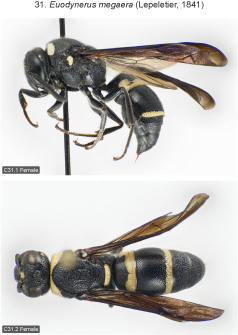
| Home | Table of contents | Keys | Species list | Glossary | Image data | PDF | Cite this article | Feedback | Updates |
Identification Atlas of the Vespidae (Hymenoptera, Aculeata) of the northeastern Nearctic region
CJAI 05, February 19, 2008
doi: 10.3752/cjai.2008.05
Matthias Buck, Stephen A. Marshall, and David K.B. Cheung
Department of Environmental Biology, University of Guelph, Guelph, Ontario, Canada N1G 2W1
Next species | Previous species | Key
31. Euodynerus megaera (Lepeletier, 1841)
Figs B5.3, 6, 8, 40, 45; C31.1–5.

|

|
Species recognition. Euodynerus megaera is very similar to E. schwarzi, from which it can be separated by the characters given in the key. Krombein (1962) separated both species based on colouration of the tibiae, development of the propodeal carina and male genitalia. The first two characters are quite variable and do not always allow separation of the two species. Many males of E. megaera have the outer surface of the tibiae as extensively pale-marked as E. schwarzi. Development of the propodeal carina is difficult to quantify, and specimens of E. megaera with weakly developed carina are hardly distinguishable from E. schwarzi with well-developed carina. Unless the genitalia are examined reliable identification of males is only possible through the newly discovered characters of the flagellum.
Variation. Fore wing length 8–10 mm (♂♂), 9.5–12.0 mm (♀♀). The hind margin of tergum 2 varies from being slightly thicker than that of tergum 3 to considerably thickened, especially in the male (thickness of hind margin up to 0.6x mid ocellar diameter). Female clypeus with a pair of ivory dorsal spots, often confluent, sometimes absent; male clypeus ivory, usually with narrow black or brownish apical margin, sometimes black margin wider, rarely apical third with irregular black mark. Female scape black, sometimes with obscure reddish white stripe below. Mesopleuron of both sexes with well-developed ivory dorsal spot. Tegula mainly black, frequently with ivory spots anteriorly and/or posteriorly. Parategula usually marked with ivory, sometimes suffused with reddish or completely black. Scutellum sometimes with a pair of small ivory spots. Terga 1 and 2 with apical fasciae; in male terga 3 and 4 often with posterolateral spots, rarely with complete fasciae, tergum 5 rarely with apicomedial spot. Apical fascia of tergum 1 expanded forward to a variable degree near lateral margin. Sternum 2 with a pair of ivory spots in posterolateral corners, rarely absent in female; in male sometimes one or more of the following sterna (up to sternum 5) with posterolateral spots. Female femora and tibiae black, in male highly variable, completely black to extensively ivory-marked including posteroapical spot and (postero-)ventral stripe on apical 2/3 of fore femur, anterior stripe on apical third of mid femur, dorsoapical spot on hind femur, and entire anterior surface of all tibiae (occasionally suffused with reddish).
Distribution. Canada: newly recorded from ON. Eastern U.S.: NY, PA and IL south to FL, west to OK and eastern TX (Krombein 1979).
Biology. Nests in borings in wood and uses agglutinated sand or less commonly mud for closing plugs and cell partitions. Preys on caterpillars of Tortricidae, Crambidae (Pyraustinae), Pyralidae (Epipaschiinae, Phycitinae), Amphisbatidae, and Erebidae (Herminiinae, formerly in Noctuidae) (Krombein 1967, 1979).
Next species | Previous species | Key
| Home | Table of contents | Keys | Species list | Glossary | Image data | PDF | Cite this article | Feedback | Updates |
